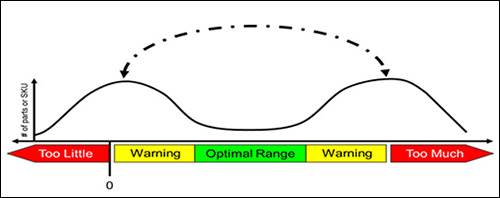Jun 27, 2018The Demand Driven Institute is concerned about the Internet of Things (IoT) and Industry 4.0. Increasing access to data, and the speed by which companies can obtain such access, without reexamining the rules by which the data is used, might squander the investments companies are making in these initiatives. Worse yet, such massive data sets may lead companies to do the wrong things faster. You cannot put jet fuel into your car with the assumption that it will now perform like a jet. The demand-driven concept represents a fundamental reexamination of the rules by which supply chains operate, and allows companies to take advantage of the access to more relevant and timely information. It also allows them to better determine what information is relevant and what is simply noise.
There is historical precedent for this concern. At the heart of most supply chains lies a planning tool called material requirements planning (MRP). Invented in the 1950s, codified in the 1960s and commercialized in the 1970s, MRP became the way of life for supply order generation and synchronization throughout the world. Yet the people that interact with MRP everyday know that something is very wrong. They may not be able to explain exactly why, but they know that if they did exactly what MRP told them to do, it would have disastrous consequences for their company and career.

There is one fatal flaw in MRP that makes it distort the relevant information that planners, companies and supply chains desperately seek. Correcting this one fatal flaw allows the promise of MRP to be attained and the bullwhip to be effectively mitigated.
As the inventory quantity expands out of the optimal zone (see the illustration below), the return on working capital captured in inventory becomes less and less as the flow of working capital slows down. The converse is also true; as inventory shrinks out of the optimal zone and approaches zero or less, revenue flow is impeded due to shortages. When the aggregate inventory position is considered in an environment using traditional MRP, a bimodal distribution is frequently noted.
Not only is the smallest population in the optimal zone, but the amount of time any individual part spends in the optimal zone tends to be short-lived. In fact, most parts tend to oscillate between the two extremes. The oscillation is depicted with the solid curved line connecting the two disparate distributions. That oscillation will occur every time MRP is run. At any given time, any planner or buyer can have many parts in both extremes simultaneously.
This bimodal distribution is rampant throughout the industry. It can be very simply described as "too much of the wrong and too little of the right" at any point in time, and "too much in total" over time. In a survey conducted by the Demand Driven Institute, 88 percent of companies reported that they experienced this bimodal inventory pattern. The sample set comprised more than 500 organizations worldwide. There are three primary effects of the bimodal distribution event in most companies:
High inventories: The distribution can be disproportionate on the excess side, as many planners and buyers will tend to err on the side of too much. This results in slow-moving or obsolete inventory, additional space requirements, squandered capacity and materials, and even lower-margin performance, as discounts are frequently required to move out the slow-moving items.
Chronic and frequent shortages: The lack of availability on just a few parts can be devastating for many manufacturing environments, especially those that have assembly operations and common materials or components. The lack of any one part will block an assembly. The lack of common materials or component will block the manufacture of all parent items calling for that common item. This means an accumulation of delays in manufacturing, late deliveries and missed sales.
High bimodal-related expenses: This effect tends to be undermeasured and underappreciated. It is the additional amount of money that an organization must spend to compensate for the bimodal distribution. When inventory is too high, third-party storage space may be required. When inventory is too low, premium and fast freight are frequently used to expedite material. Overtime is then used to push late orders through the plant. Partial shipments are made to get the customer some of what it ordered, but with significantly increasing freight expenses.
These three effects are indicative of major flow problems in most organizations. Furthermore, they are directly tied to conventional planning activities and efforts in these organizations. Unless the IoT is carefully evaluated, it will follow the "precisely wrong" path experienced using MRP.
A new depth of understanding about conventional planning has resulted in a list of actions that can begin immediately. Just as demand-driven planning mechanisms provide a roadmap of all levels to drive adaptation and promote the flow of relevant information, the IoT has the promise of surviving and thriving in today's complex and volatile environments when systemic root-causes are considered.
Carol Ptak, CFPIM, CIRM, DDPP, DDLP, is a co-founder and partner with the Demand Driven Institute. Carol spent decades in supply chain management, first as a practitioner and then as a consultant and software executive. She is also a past president of APICS, and has authored several books on demand-driven methods, MRP, enterprise resource planning, lean manufacturing and the theory of constraints (TOC).
Chad Smith, DDPP, DDLP, is a co-founder of the Demand Driven Institute. Chad spent 20 years in supply chain and management consulting and software, co-founded industry innovator Constraints Management Group and worked personally with Dr. Eli Goldratt. He has co-authored and contributed to several books on demand=driven methods, MRP and TOC.
You can read more about demand-driven material requirements planning here.


